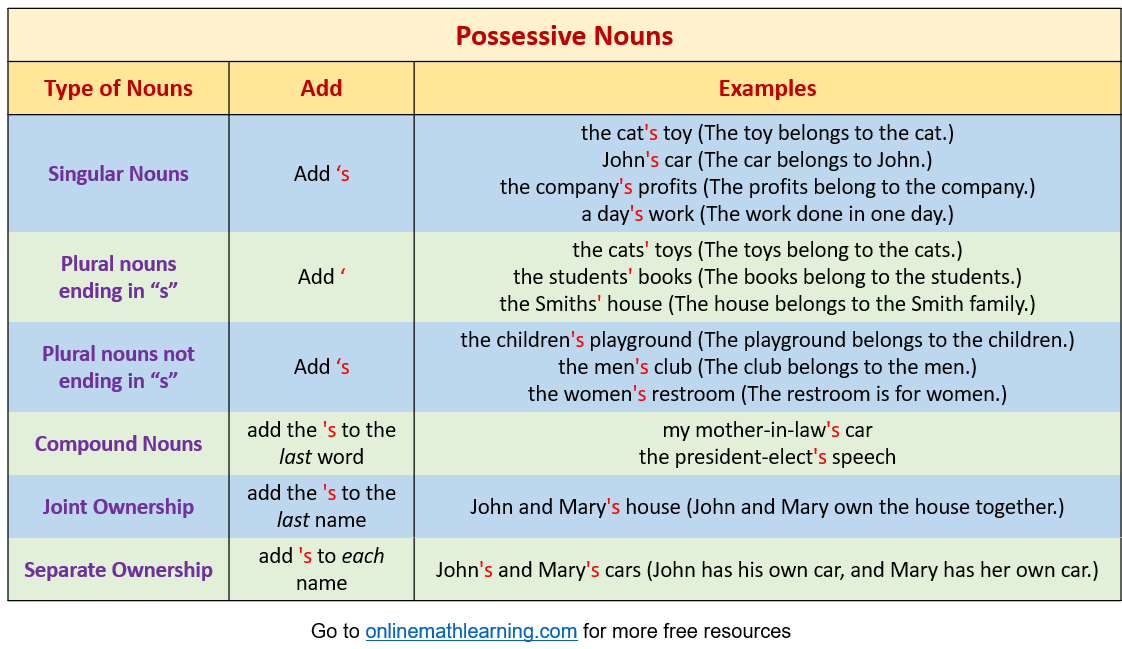Possessive Nouns
Related Pages
Possessive Pronouns
Gender Nouns
Proper Nouns
More Lessons On English Grammar
In these lessons, we will learn
- how to use possessive nouns
- the rules for forming possessive nouns
- possessive singular nouns and possessive plural nouns
The following diagram gives some general rules for possessive nouns: singular nouns, plural nouns ending in “s”, plural nouns not ending in “s”, compound nouns, joint ownership and separate ownership. Scroll down the page for more examples and rules.

What are Possessive Nouns?
Possessive nouns are nouns that show “relationships”
- Possessive nouns can be used to show ‘belonging to’ or ‘ownership’.
Examples:
This is Jill’s house. (Jill owns the house)
They were not able to find Paul’s shoes. (The shoes belong to Paul)
The cat’s dish is empty.
The lamp’s base is broken.
- Possessive nouns can show where someone works or studies or spends time.
Examples:
I went to Jack’s school.
Put this box in Colin’s office.
- Possessive nouns can indicate family relationships.
Examples:
Gordon’s mother is a dentist.
He went with Brian’s brother.
General Rules for Forming Possessive Nouns
Rule 1:
Add an apostrophe s (‘s) to form the possessive of
singular nouns. This rule also applies to singular nouns ending in
s.
Examples:
| Singular Nouns | Possessive Nouns |
| lamp | lamp’s |
| egg | egg’s |
| branch | branch’s |
| mango | mango’s |
| Paul | Paul’s |
| Simon | Simon’s |
| goose | goose’s |
| woman | woman’s |
| leaf | leaf’s |
| lady | lady’s |
| bus | bus’s |
| class | class’s |
Rule 2:
Add an apostrophe s (‘s) to form the possessive of
plural nouns that do not end with s.
Examples:
| Plural Nouns | Possessive Nouns |
| geese | geese’s |
| oxen | oxen’s |
| women | women’s |
| children | children’s |
Rule 3:
Add an apostrophe (‘) to form the possessive of
plural nouns that end with s.
Examples:
| Plural Nouns | Possessive Nouns |
| lamps | lamps’ |
| eggs | eggs’ |
| branches | branches’ |
| mangoes | mangoes’ |
| leaves | leaves’ |
| ladies | ladies’ |
| buses | buses’ |
| classes | classes’ |
Rule 4:
For the names of people that end with s, add an apostrophe s (‘s)
or apostrophe (‘). (Both methods are acceptable.)
Examples:
| Names of People that ends with s | Possessive Nouns |
| Phyllis | Phyllis’s or Phyllis’ |
| Thomas | Thomas’s or Thomas’ |
| Jones | Jones’s or Jones’ |
Rule 5:
Add an apostrophe s (‘s) or apostrophe (‘) to the end of a compound noun.
Examples:
| Compound Noun | Possessive Noun |
| classroom | classroom’s |
| classrooms | classrooms’ |
| fire engine | fire engine’s |
| fire engines | fire engines’ |
| son-in-law | son-in-law’s |
| son-in-laws | son-in-laws’ |
Apostrophe Rules
Showing Possession
Learn with examples
Apostrophe S - Possessive Nouns in English
When to use an apostrophe in English
Possessive Nouns.
Learning Phonics
| Short Vowels | ||
|---|---|---|
| Short A | Short E | Short I |
| Short O | Short U | Short Vowels |
| Long Vowels | ||
|---|---|---|
| Long A | Long E | Long I |
| Long O | Long U | Y (vowel) |
| Long Vowels | Short, Long Vowels | Rhyming Words |
| Short & Long Vowels | ||
|---|---|---|
| Short & Long A | Short & Long E | Short & Long I |
| Short & Long O | Short & Long U | Short I & Long E |
The following printable worksheets can be used to practice writing CVC words while reinforcing reading.
| Free Printable Worksheets (CVC Words) | |
|---|---|
| Set 1 Match CVC Words Write CVC Words Match & Write Spell CVC Words Sort CVC Words |
Set 2 Match CVC Words Write CVC Words Spell CVC Words Sort CVC Words Match Phrases |
| Set 3 Match CVC Words Write CVC Words Spell CVC Words Sort CVC Words Match Phrases |
CVC, CCVC or CVCC Match Words Write Words |
| Consonant Digraphs | ||
|---|---|---|
| CH Sound | SH Sound | Soft TH |
| Hard TH | WH Sound | PH Sound |
| GH Sound | NG Sound | Consonant Digraphs |
Free Printable Worksheets for Consonant Digraphs
These worksheets focus on the consonant digraphs: ch, sh, th, qu and ng.
| Printable Worksheets (Consonant Digraphs) | |
|---|---|
|
Learning "ch" |
Learning "sh" |
|
Learning "th" |
Learning "qu" |
|
Learning "ng" |
|
Free Printable Worksheets for Digraphs
| Printable Worksheets (EE, OO, OU, OI, AW) | |
|---|---|
|
EE Words |
OO Words |
|
OI Words |
AW Words |
Types of Verbs
Action Verbs
Is, Am, Are
Has, Have
Spelling Rules for Verbs
Adding -ed
Irregular Verbs
Adding -ing
Others
Rhyming Words
Sentence Types
Contractions
Possessive Nouns
Try the free Mathway calculator and
problem solver below to practice various math topics. Try the given examples, or type in your own
problem and check your answer with the step-by-step explanations.

We welcome your feedback, comments and questions about this site or page. Please submit your feedback or enquiries via our Feedback page.